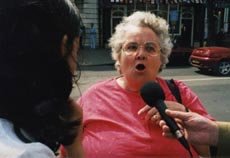William Furlong
dal 21/1/2009 al 8/4/2009
Segnalato da
21/1/2009
William Furlong
Laure Genillard, London
For this project, the artist presents 4 sound frames and 4 graphic works. He has always been fascinated with the recording process, how it can make soundings in the discourses of art, and be used to inform and disseminate creative activity. In this series of new works, Furlong abstracts words and phrases from original interviews with artists, transferring them to sound frames.

William Furlong has worked with the recorded voice since the early 1970's,
when he established Audio Arts Magazine on audiocassette.
For this project, the artist presents 4 sound frames and four graphic works.
He has always been fascinated with the recording process, how it can make
soundings in the discourses of art, and be used to inform and disseminate
creative activity.
In this series of new works, Furlong abstracts words and phrases from
original interviews with artists, transferring them to four 'sound frames'.
Each sound frame contains twelve loud speakers from which orchestrated and
choreographed sequences of fragmented speech are interwoven and layered into
rhythmic, resonant and allusive sound-scenes.
On occasions, these abstract constructions imply the possibility of a
conversation, but lack any 'before and after' narrative. The actual meanings
of what is being said goes into and out of focus, like fragments of
encounters barely over-heard, snatches from conversations that might have
been or might still occur.
It is a kind of orchestration of voices, not a presentation (with
complications) of attitudes or arguments. Layering, repetition, rhythm,
abstraction: a kind of music, but not melodic. A recognition that the
antiphonal music of human voices can (as in Joyce) transform into pure sound
that is expressive of human beings, rather then human assertion. The art of
the piece itself counters the discourse from which the fragments are
abstracted! (Mel Gooding 2008)
Image: Street interview, 2002
Private view: Thursday 22nd January
Laure Genillard
2 Hanway Place - London
Wed - Sat 2 - 6 PM
Free admission



